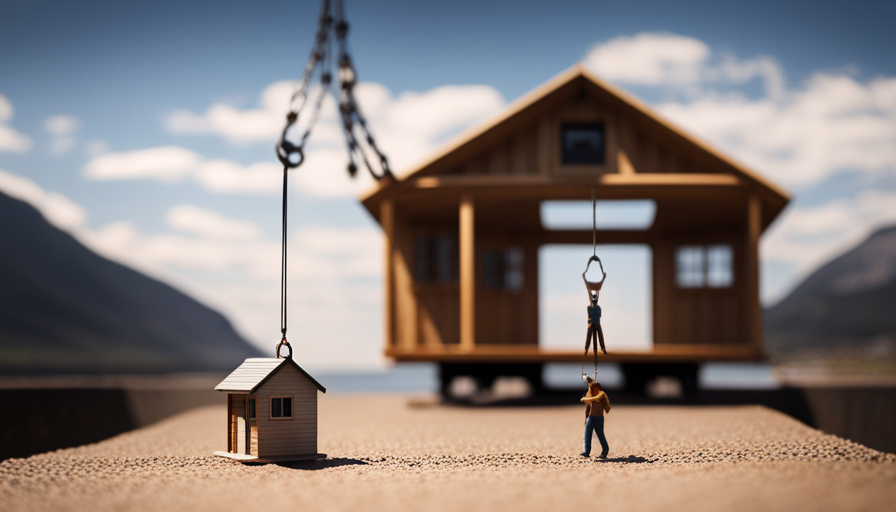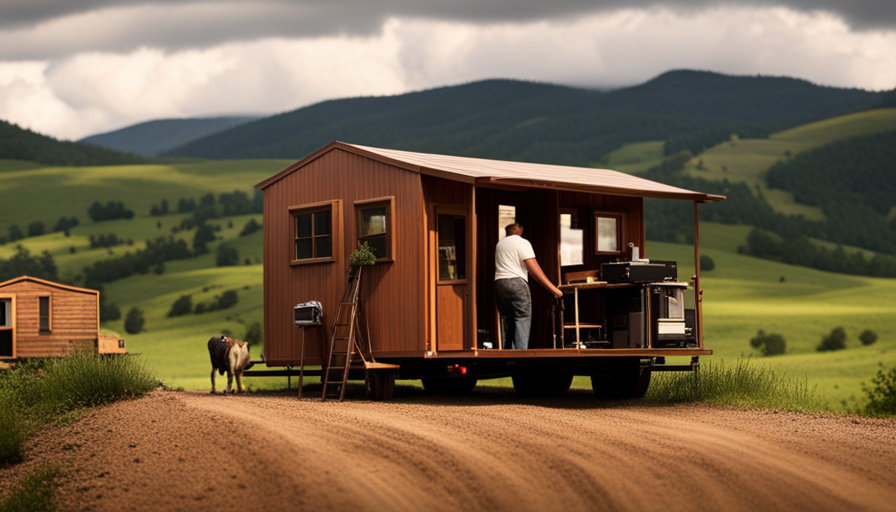Regarding tiny homes, the initial thought might be their diminutive scale, however, their mass is just as critical. Just as the adage advises not to assess a book by its exterior, this principle applies to tiny homes as well.
You might be surprised to learn just how heavy a 9 x 18 tiny house can be. In this article, I will delve into the intricacies of understanding the weight of these compact dwellings.
From the materials used in construction to the factors that affect weight, we will explore all the details. Additionally, we will examine weight distribution and provide tips for reducing the weight of your 9 x 18 tiny house. Towing and transportation considerations will also be discussed, as well as potential challenges for heavier tiny houses.
So, if you’re ready to uncover the hidden weight of these pint-sized homes and find the perfect balance between weight and functionality, let’s dive right in!
Key Takeaways
- A 9 x 18 tiny house can weigh between 8,000 and 12,000 pounds, making size and weight important factors to consider.
- Factors influencing the weight of a tiny house include construction materials, furniture, and appliances, with proper weight distribution being crucial for stability and safety.
- Commonly used construction materials for tiny houses include SIPs, bamboo, and recycled materials, with fiber cement siding being popular for its durability and low maintenance.
- Tips for reducing the weight of a 9 x 18 tiny house include using lightweight materials, making smart layout choices, and eliminating unnecessary features.
Understanding the Dimensions of a 9 x 18 Tiny House
Have you ever wondered how heavy a 9 x 18 tiny house can be? Well, let’s dive into the dimensions and weight distribution of these compact dwellings to gain a better understanding.
The dimensions of a 9 x 18 tiny house refer to its length and width, measuring 9 feet by 18 feet. However, it’s important to note that the height can vary depending on the design and style of the house.
When it comes to weight distribution, tiny houses are built to be structurally sound and balanced. The weight is distributed evenly throughout the entire structure, ensuring stability and safety. This is achieved through careful planning and engineering, considering factors such as the placement of walls, furniture, and appliances.
To determine the exact weight of a 9 x 18 tiny house, it’s crucial to consider the materials used in its construction. This will be discussed in the subsequent section. By choosing lightweight yet durable materials, builders can minimize the overall weight of the house without compromising its strength.
Understanding the dimensions and weight distribution of a 9 x 18 tiny house is essential for designing and constructing these small living spaces. Now, let’s delve into the materials used in the construction of tiny houses, which play a vital role in determining their weight and overall quality.
Materials Used in the Construction of Tiny Houses
You’ll be amazed at the weight of a 9 x 18 micro dwelling when you consider the sturdy materials that were skillfully crafted together. The construction materials used in tiny houses are carefully chosen to ensure durability and functionality while keeping the weight as low as possible.
Here are some eco-friendly options commonly used in the construction of tiny houses:
-
Structural Insulated Panels (SIPs): These panels consist of a foam core sandwiched between two layers of structural board. They’re lightweight, energy-efficient, and provide excellent insulation.
-
Bamboo: Known for its strength and sustainability, bamboo is a popular choice for flooring, cabinets, and furniture in tiny houses. It’s lightweight and has a unique aesthetic appeal.
-
Recycled Materials: Many tiny house builders opt to use reclaimed or salvaged materials, such as reclaimed wood, recycled metal, or repurposed windows. These materials not only reduce the environmental impact but also add character to the house.
-
Fiber Cement Siding: This durable and low-maintenance siding option is often used in tiny houses. It’s rot-resistant, fire-resistant, and lightweight.
Considering these construction materials, the weight of a 9 x 18 tiny house falls within a reasonable range. Transitioning into the subsequent section about the average weight range of 9 x 18 tiny houses, it’s important to understand how the materials used contribute to the overall weight.
Average Weight Range of 9 x 18 Tiny Houses
Imagine stepping inside a 9 x 18 micro dwelling and feeling the solidity of its construction, as if it were a miniature fortress.
The average weight range of a 9 x 18 tiny house typically falls between 8,000 to 12,000 pounds. This weight can vary depending on the construction materials used, as well as the design choices made by the builder. The weight of a tiny house is a crucial consideration, as it affects its transportability and the foundation requirements.
To ensure structural integrity, builders often use lightweight yet sturdy materials such as steel or aluminum for the frame. The walls are commonly made of wood or composite materials, providing both strength and insulation. The roof is usually constructed with metal or shingles, depending on the desired aesthetic and climate conditions. Windows and doors are carefully selected to balance weight and functionality.
Other factors that affect the weight of a tiny house include the size and type of appliances, furniture, and utilities installed. By understanding the average weight range and considering the construction materials, builders can create a well-balanced and durable tiny house.
Transitioning into the next section, let’s now explore the various factors that can influence the weight of a tiny house.
Factors that Affect the Weight of a Tiny House
Picture the potential pounds that can be piled onto a petite dwelling as its weight is influenced by a plethora of precise factors. When considering the weight of a tiny house, there are several key factors that come into play. These factors affect not only the overall weight of the structure but also its stability and mobility.
Factors Affecting Weight:
- Building materials: The type of materials used in construction, such as wood, steel, or concrete, significantly impact the weight of a tiny house.
- Appliances and fixtures: The inclusion of heavy appliances like refrigerators, ovens, or water heaters can add significant weight to the overall structure.
- Furnishings and personal belongings: The amount of furniture, storage, and personal items inside the tiny house also contribute to its weight.
- Insulation and finishes: The insulation and finishes used in the construction process can add additional weight to the tiny house.
- Roofing materials: The type of roofing materials, such as metal or shingles, can affect the weight of the structure.
Considering these factors is crucial for ensuring the weight of the tiny house remains within a safe and manageable range.
In the next section, we’ll examine the weight distribution in a tiny house, which further influences its overall stability and functionality.
Examining the Weight Distribution in a Tiny House
To understand how weight is distributed in a compact dwelling, let’s take a closer look at its structure and layout. In a tiny house, weight distribution plays a crucial role in ensuring stability and safety.
The construction materials used in the building process greatly impact the overall weight distribution of the house. For instance, heavier materials like wood and metal will affect the weight distribution differently compared to lighter materials like fiberglass or foam panels.
Additionally, the placement of these materials within the house is equally important. The distribution of weight across the floor, walls, and roof must be carefully balanced to prevent any structural issues. For example, if the majority of the weight is concentrated on one side of the house, it could lead to uneven weight distribution and potential tilting or even collapse.
Therefore, proper weight distribution in tiny house design is crucial for maintaining structural integrity and ensuring the overall safety and durability of the dwelling. It’s imperative to consider weight distribution at every stage of the construction process, from choosing the right materials to strategically placing them throughout the tiny house. This ensures that the weight is evenly distributed, minimizing the risk of any structural issues.
The Importance of Proper Weight Distribution in Tiny House Design
Ensuring proper weight distribution in the design of a compact dwelling is essential for maintaining structural integrity and preventing any potential issues. The importance of proper weight distribution can’t be overstated, as it affects the overall stability, safety, and longevity of a tiny house. Challenges in weight management arise due to the limited space available in a tiny house, requiring careful consideration of every element and its placement.
To achieve proper weight distribution in a tiny house design, the following factors should be taken into account:
-
Balance: Distributing the weight evenly across the tiny house is crucial to avoid putting excessive stress on certain areas. This includes considering the placement of heavy appliances, furniture, and storage options.
-
Axle Placement: Positioning the axles correctly is vital for ensuring proper weight distribution on the trailer. This involves calculating the weight of the tiny house and placing the axles accordingly to achieve optimum weight distribution.
-
Floor Construction: The type and thickness of the flooring material play a significant role in weight distribution. Using lightweight but durable materials can help reduce overall weight and ensure proper weight distribution.
-
Roof Load: The weight of the roof is another critical aspect to consider. Proper support systems and materials should be used to evenly distribute the weight of the roof and prevent any structural issues.
In the next section, we’ll explore tips for reducing the weight of a 9 x 18 tiny house without compromising its structural integrity.
Tips for Reducing the Weight of a 9 x 18 Tiny House
One effective way to make a 9 x 18 compact dwelling lighter without compromising its structural integrity is by implementing smart design choices. When it comes to reducing weight, maximizing space is crucial.
One tip for achieving this is to use lightweight materials in the construction of the tiny house. For example, opting for aluminum framing instead of wood can significantly reduce the overall weight. Additionally, choosing lightweight insulation materials and thin but durable flooring options can also contribute to weight reduction.
Another strategy is to carefully plan the layout of the tiny house to make the most efficient use of space. Incorporating multi-functional furniture, such as a sofa that can double as a bed or storage compartments built into staircases, can help maximize space while minimizing weight.
Furthermore, eliminating unnecessary features or reducing the size of non-essential elements can further reduce weight. By following these tips, it’s possible to create a lighter 9 x 18 tiny house without compromising its structural integrity.
Considering the weight reduction measures, it’s important to also take into account considerations for towing and transportation of tiny houses.
Considerations for Towing and Transportation of Tiny Houses
When it comes to transporting your compact dwelling, you need to carefully consider the logistics and practicality of towing a small, mobile home. Towing a tiny house requires understanding the towing limitations and ensuring proper weight distribution.
Here are a few considerations for towing and transportation of tiny houses:
-
Weight Distribution: It’s crucial to distribute the weight evenly throughout the tiny house to ensure stability and safe towing. Uneven weight distribution can lead to swaying, fishtailing, or even tipping over during transportation. By placing heavier items closer to the center and making sure the load is balanced, you can minimize these risks.
-
Towing Limitations: Every towing vehicle has a maximum weight it can safely tow. It’s important to know the towing capacity of your vehicle and ensure that the weight of your tiny house, including all its contents, doesn’t exceed this limit. Exceeding the towing capacity can strain the vehicle’s engine, transmission, and brakes, putting you at risk of accidents or mechanical issues.
-
Trailer Specifications: Consider the size and design of the trailer used to transport your tiny house. The trailer should be sturdy enough to handle the weight and dimensions of the tiny house. Additionally, ensure that the trailer has proper braking systems and is equipped with safety features such as lights and reflectors.
Considering these factors will help you navigate the towing and transportation process with ease. In the next section, we’ll explore potential challenges and considerations for heavy tiny houses without skipping a beat.
Potential Challenges and Considerations for Heavy Tiny Houses
To successfully transport your compact dwelling, you’ll need to navigate potential challenges and considerations that arise with weighty mobile homes. Heavy tiny houses can present a variety of challenges, from the construction materials used to the limitations of towing vehicles. One of the main challenges is the weight of the house itself. The heavier the house, the more strain it puts on the towing vehicle and the more difficult it becomes to transport.
When it comes to construction materials, some tiny houses are built with heavier materials, such as steel or concrete, which can significantly increase the weight of the house. While these materials offer durability and stability, they also pose challenges when it comes to transportation. Additionally, heavy tiny houses may require special permits or escorts to comply with transportation regulations.
To provide a clearer understanding of the challenges and considerations related to heavy tiny houses, here is a table that compares the weight of different construction materials commonly used in tiny house construction:
| Construction Material | Weight per square foot (lbs) |
|---|---|
| Wood | 8 – 12 |
| Steel | 12 – 20 |
| Concrete | 18 – 30 |
Finding the right balance of weight and functionality is crucial when it comes to towing and transporting a tiny house. In the next section, we will discuss the conclusion of this topic and provide insights on how to achieve this balance effectively.
Conclusion: Finding the Right Balance of Weight and Functionality
Achieving the perfect combination of weight and functionality is crucial for successfully towing and transporting a compact dwelling. When it comes to tiny houses, finding the right balance between weight and functionality is essential to ensure a safe and efficient travel experience.
To truly grasp the importance of this balance, let’s consider the emotional impact it can have on both the homeowner and the tiny house community.
-
On a personal level, having a well-balanced tiny house means peace of mind during travel. It evokes a sense of security, knowing that your home is stable and can withstand the journey ahead.
-
Additionally, it fosters a feeling of freedom and adventure, as a well-designed and lightweight tiny house allows for easier exploration and mobility.
On a broader scale, finding the right balance between weight and functionality contributes to the overall reputation and acceptance of tiny houses as a viable housing option. By demonstrating that these dwellings can be safely transported and utilized for various purposes, it helps dispel any doubts or misconceptions surrounding tiny house living.
The journey to finding the right balance of weight and functionality is crucial for the successful towing and transportation of a tiny house. Not only does it provide a sense of security and freedom to the homeowner, but it also helps shape the perception of the tiny house movement as a whole.
Frequently Asked Questions
How much does a 9 x 18 tiny house typically weigh when fully furnished?
When fully furnished, a 9 x 18 tiny house typically weighs around 8,000 to 10,000 pounds. Factors affecting the weight include the materials used for construction, such as wood or steel, as well as the appliances, furniture, and other amenities added inside.
To calculate the weight capacity of a 9 x 18 tiny house, one must consider the structural integrity of the building, the load-bearing capacity of the foundation, and the weight distribution of the furnishings and occupants.
What are some common materials used in the construction of 9 x 18 tiny houses?
Wood, steel, fiberglass, and concrete are some common materials used in the construction of 9 x 18 tiny houses. These materials offer a sturdy foundation and ensure durability.
When fully furnished, the weight of a 9 x 18 tiny house typically falls within a weight range of 8,000 to 12,000 pounds, with an average weight of around 10,000 pounds. This weight is dependent on the specific design, materials used, and level of customization.
Are there any specific factors that can significantly increase the weight of a 9 x 18 tiny house?
Factors affecting the weight of a 9 x 18 tiny house include various elements that can significantly increase its overall mass. The choice of materials plays a crucial role, as opting for lightweight materials like aluminum or composite panels can help reduce the weight.
However, additional factors such as the size and number of windows, insulation type, and the inclusion of appliances or furniture can also contribute to the overall weight of the tiny house.
It’s important to consider these factors when aiming for a lightweight structure.
How does weight distribution affect the stability and safety of a tiny house?
Weight distribution plays a crucial role in the stability and safety of a tiny house. Properly distributing the weight ensures that the structure remains balanced and prevents any potential tipping or instability.
To calculate weight distribution, one must consider the placement of heavy items such as appliances, furniture, and water tanks. It’s important to evenly distribute the weight across the foundation and axles to maintain optimal balance and prevent any strain on the structure.
Neglecting proper weight distribution can lead to structural damage and compromise the safety of the tiny house.
What are some tips for reducing the weight of a 9 x 18 tiny house without compromising its functionality?
To reduce the weight of a 9 x 18 tiny house without compromising functionality, there are a few key tips to keep in mind.
Firstly, maximize storage by utilizing vertical space and incorporating clever storage solutions.
Secondly, choose lightweight building materials such as lightweight steel or aluminum framing, composite panels, and foam insulation. These materials are strong, durable, and significantly lighter than traditional alternatives.
By following these tips, you can create a lighter tiny house without sacrificing functionality.
Conclusion
After diving deep into the world of tiny houses and exploring the weight of a 9 x 18 tiny house, it’s clear that finding the right balance of weight and functionality is crucial.
Like a finely tuned instrument, the weight distribution in a tiny house must be carefully considered to ensure stability and safety.
As we navigate the challenges of towing and transportation, we must be mindful of the potential pitfalls of a heavy tiny house. But fear not, for with tips and tricks for reducing weight, we can create a harmonious and lightweight abode.
Let’s embark on this tiny house journey with confidence, knowing that we can achieve the perfect balance.
Hi, I’m Emma. I’m the Editor in Chief of Tiny House 43, a blog all about tiny houses. While tree houses are often associated with childhood, they can be the perfect adult retreat. They offer a cozy space to relax and unwind, surrounded by nature. And since they’re typically built on stilts or raised platforms, they offer stunning views that traditional homes simply can’t match. If you’re looking for a unique and romantic getaway, a tree house tiny house might just be the perfect option.










